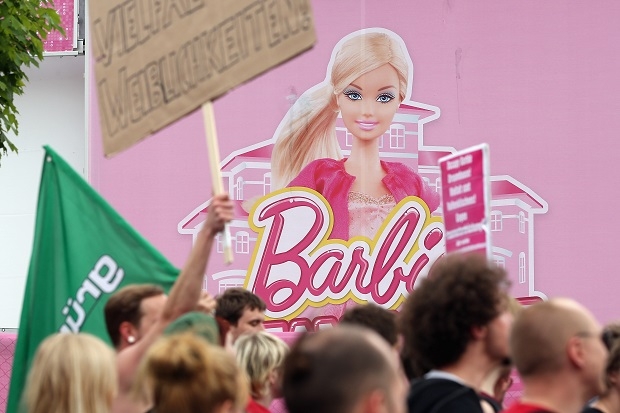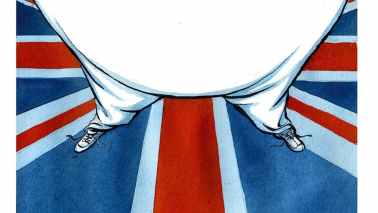I felt a touch of sadness on Tuesday when Marks & Spencer caved in to demands that they de-gender their toys, which must make me the worst person on earth.
After her triumphant campaign, MP Stella Creasy tweeted:
if it annoys some so much girls might want 2 play with cars, imagine how they’d feel if they knew also wanted 2 run companies & stuff! ;-@
— stellacreasy (@stellacreasy) December 18, 2013
Is that why, though? What annoys a lot of people is that a vocal pressure group professing outrage, the universally accepted currency of public discourse, has limited customers’ options. It’s like when people complain about Amazon selling costumes that offends some victim group whom they claim to represent. Every time that happens, if you look closely enough, you can see a little tear drop from the eyes of Nelson’s Column, as Britain’s spirit dies.
This is not about whether such pinky toys are revolting and depressingly uninspiring for young girls, which they unquestionable are. But such campaigns ultimately won’t make the slightest bit of difference, because they ignore the causes of the social change they decry.
The underlying concern is that girls are being pressured into a certain sexualised, submissive and ultra-feminine ideal, one that is based on looks and shopping.
The reason for this development is that we have become much freer and richer. American blogger Steve Sailer has made the point that in the Victorian era when all kids got for Christmas was a tangerine and a lump of coal there wasn’t much opportunity for gendered toys. The larger the market becomes the more diversified, so that where there was basically one standard Lego set in the 1970s there are now countless different types, including some that are directly marketed at either sex.
As well as wealth it is also a product of sexual and personal freedom; the more freedom you have, and the fewer external pressures on how you are supposed to behave, the more diversified our nature will be. On top of gay or transgender people coming out some will become hyper-masculine or hyper-feminine, as has happened in US and British popular culture generally. That ideal filters down to children, too.
Given freedom and tolerance, people may express their identities in a more exaggerated way, but they can’t be pressured into being something that goes against their desires. The idea that manufacturers and marketing people can somehow ‘make’ girls like girly toys is as mad as the idea that ‘propaganda’ can turn heterosexuals gay. All the evidence suggests that such preferences and characteristics are very much in place by the time we are born.
There is a trade-off between sexual freedom and sexual equality, as there is between all types of freedom and equality. Personally I would lean towards the latter, but then I would, looking like this; but no one even accepts that there is a trade-off.
If campaigners want to regulate the market and start banning things, they should say so, but simply trying to rebrand something as gender-neutral is going to make absolutely no difference. Firms will market them at girls and boys but in more subtle ways, until campaigners complain that the Delta Squad Army of Death Battalion toy set doesn’t have enough female figures in it and – incredibly – it’s clearly being targeted at boys.
All this sort of pressure does is give an even bigger advantage to online shops, which can target their customers far better because they have more of an idea of what they buy, rather than using useful-but-crude divisions like ‘boys’ and ‘girls’.
When campaigners talk about ‘stereotyping’ and ‘pigeon-holing’, do they have any idea that that is the very nature of running a business? Every business has a target market. Toy-sellers, like any company on earth, market their products at particular demographics, and in the case of children’s toys this divides to a certain extent by sex because of the nature of boys and girls.
If your daughter is upset because the boys have better toys, as some people argue, explain to her that because on average boys like some toys more it makes financial sense for companies to market them as ‘boy’s toys’. On average – it’s a useful term to teach them, one that will help them understand human behaviour but which lots of grown-ups seem incapable of understanding. Explain that these differences are on average but do not have to apply to them, because that is the nature of average differences between the sexes – there is plenty of overlap, and there’s nothing wrong with that.
Personally, I used to like the Care Bears when I was young and look at me now – the brain of Steven Pinker and the body of Khal Drogo. One of my daughters likes pretty girly toys, one has slightly more mixed tastes, but I like to think that they are free to decide either way (we also don’t let them watch adverts, so long as we’re able to understand the remote control better than they do).
But as for telling them that boys and girls only like toys because society creates gender stereotypes for them: if you want your daughters to understand science, the last thing you should be doing is teaching them a secular version of creationism in which gender is a social construct.
Speaking of which, one thing I don’t understand is why no one has thought of a Barbie-sized plastic doll of Marie Curie, which would be popular with liberal middle-class parents. Or Emmeline Pankhurst. Or maybe even Stella Creasy. Plus accessories, of course – handbags, dresses etc etc.







Comments